








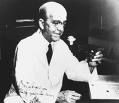












TLW's Biologistscope™ (Biologist Historyscope) |
By T.L. Winslow (TLW), the Historyscoper™ |
© Copyright by T.L. Winslow. All Rights Reserved. |
Original Pub. Date: Jan. 6, 2017. Last Update: Sept. 18, 2025. |


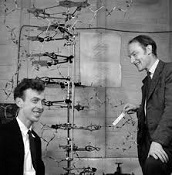







Westerners are not only known as history ignoramuses, but double dumbass history ignoramuses when it comes to biology and biologist history. Since I'm the one-and-only Historyscoper (tm), let me quickly bring you up to speed before you dive into my Master Historyscope.

In 335 B.C.E. Stagira, Macedonia-born Greek Golden Mean philosopher (the first scientist?) Aristotle (Gr. "best (purpose) of all") of Stagira (-384 to -322) parts ways with Plato and founds the Lyceum in E Athens, becoming the teacher of undefeated world conqueror Alexander III the Great, preferring to collect data rather than sit around thinking, and (after much personal experimentation?) deciding that all inheritance comes from the father, the mother merely providing the material, and that female babies are caused by "interference" from the mother; he leaves 260 treatises, incl. Constitution of Athens (written in -350) (discovered in 1890 C.E.), Physics, Metaphysics, Ethics, Logic (Prior Analytics), Zoology, De Anima (On the Soul) (the nous poietikos or active intellect vs. the nous pathetikos or passive intellect), which first mentions the Tabula Rasa view of the mind as starting out a blank slate, and Poetics, the first work on art criticism, valuing art based on how it imitates the universal in human nature, and claiming criticism as a science: "Man is by nature a political animal"; "Hope is a waking dream"; "Tyrants preserve themselves by sowing fear and mistrust among the citizens by means of spies, by distracting them with foreign wars, by eliminating men of spirit who might lead a revolution, by humbling the people, and making them incapable of decisive action"; "Music directly represents the passions of the soul. If one listens to the wrong kind of music, he will become the wrong kind of person."

In 1551 Swiss naturalist Conrad Gessner (Konrad von Gesner) (1516-65) pub. Historiae Animalium (5 vols.) (4.5K pages) (1551-8), founding modern Zoology (Animal Biology); in 1554 he pub. the first scientific description of the Guinea pig; the earliest known portrait of a guinea pig is painted in Elizabethan England in 1580.

In 1670 Italian scientist Giovanni Alfonso Borelli (1608-79), known for his experiments in biomechanics describes a mechanical bird with artificial wings, attempting to explain flight by means of an inclined plane. In 1680 he pub. De Motu Animalium (On the Motion of Animals), financed by Queen Christina of Sweden (who gives him protection from Galileo's fate), which links Galilean mechanics to Cartesian mechanistic biology, founding the science of Biomechanics; recognizes that forward motion requires forward movement of the body's center of gravity, followed by swinging of the limbs to maintain balance; likens the action of the heart to a piston, requiring the arteries to be elastic - the heart is like the Sun, and the weenie is like the Moon?

In 1673 41-y.-o. Delft-born Dutch self-taught scientist Antonie (Anton) Phillips van Leeuwenhoek (1632-1723) (low-en-hook) ("lion's corner") pub. his first article in the Philosophical Transactions of the Royal Society of London announcing his groundbreaking microscopic observations of mold, bees, and lice made with his homemade lenses, which advance the state of the art, giving him a virtual scientific monopoly; next year he discovers that the moving objects observed by his microsopes are little animals - a late bloomer?
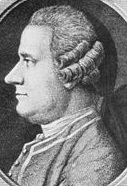
In 1779 Dutch chemist-biologist Jan Ingenhousz (1730-99) discovers that plants need carbon dioxide, and that they need light in order to produce oxygen.

In 1779 Italian biologist Lazzaro Spallanzani (1729-99) proves that sperm and egg must come into contact for fertilization to occur, and invents Artificial Insemination - don't be lazy and spill any?

In 1786 Italian scientist Luigi Galvani (1737-98) discovers that nerves transmit electricity, and goes on in 1789 to experiment on the muscular contraction of dead frogs.

In Apr. 1796 French naturalist Jean Leopold Nicolas Frederic Georges Cuvier (1769-1832) gives the lecture Mémoires sur les espèces d'éléphants vivants et fossiles at the Nat. Inst. (pub. in 1800), comparing skeletons of Indian and African elephants, and mastodons ("the Ohio animal"), which he concludes are all different species, the latter extinct; in 1806 he coins the name "mastodon"; he also describes a large skeleton found in Paraguay, which he names the Megatherium, claiming it is an extinct variety of the tree-dwelling sloth, ending the debate about whether extinction has actually happened, and founding Comparative Anatomy and Paleontology. In 1798 he pub. Tableau élémentaire de l'histoire naturelle des animaux, becoming the first attempt at systematic classification of the animal kingdom, founding modern Zoology (Comparative Anatomy), stressing how the parts of an organism are correlated to the functioning whole. In 1812 he pub. Recherches sur les Ossements Fossiles de Quadrupedes (Researches on Quadruped Fossil Bones), issuing his "rash dictum" that it is unlikely that any large animal remained undiscovered. In 1813 he pub. Essay on the Theory of the Earth, which advances the theory of catastrophism in geology, claiming that new species were created after periodic catastrophic floods after establishing the fact of past extinction. In 1817 he pub. Le Règne Animal (The Animal Kingdom) (4 vols.), his magnum opus, a summation of his life's work on comparative anatomy, containing apparent support for evolutionary change for the extinct mammoths et al., making a fan of Charles Darwin, although Cuvier rejects the idea of evolution.
In 1797 Thomas Jefferson gives a scientific lecture on a "sloth" which later turns out to be a feline; sloths are cold-blooded, see...


In 1802 French naturalist Jean-Baptiste Pierre Antoine de Monet, Chevalier de Lamarck (1744-1829) pub. Hydrogeologie, coining the term "biology", and claiming that continents march steadily westward; he also pub. Recherches sur l'Organisation des Corps Vivans, proposing the theory of evolution, but without describing a mechanism. In 1802 German naturalist Gottfried Reinhold Treviranus (1776-1837) pub. Biologie: Oder die Philosophie der Lebenden Natur, independently coining the term "biology", and proposing the transmutation of species - God holds it remarkably up his anus?

In Nov. 1846 Swiss biologist-geologist Jean Louis Rodolphe Agassiz (1807-73) crosses over to the U.S. to take up a position as prof. of zoology and geology at Harvard U., going on to publicize the doctrine of polygenism, which claims that each species was created by God in "special provinces" and endowed with unequal attributes, denying any role for migration and adaptation, and that the conditions in which particular creatures live "are the conditions necessary to their maintenance, and what among organized beings is essential to their temporal existence must be at least one of the conditions under which they were created", rejecting monogenism as leading to impersonal atheistic materialism and regarding the Bible book of Genesis as recounting the origin of the white race only, helping found scientific racism and making him popular for at least a cent.

In 1834 German physiologist (histologist) Theodor Schwann (1810-82) discovers the catalytic role of pepsin (from Gr. "digestion") in gastric juice - too early to be given the "-ase" suffix. In 1837 he recognizes that the yeast cell is a living organism, naming it saccharomyces (Gr. "sugar fungus") for its sweet tooth, also recognizing that fermentation is an anaerobic process, helping turn beer brewing into a science, going on to generalize that cells are the common structural and functional unit of all living organisms - and likes to paint his trucks mustard yellow? In 1839 the vitalist theory of animal life is dumped, and the cell-growth theory of biology is boosted with his discovery of animal cells, consisting of protoplasm separated by membranes, all mature tissues of animals being traceable to embryonic, nucleated cells.
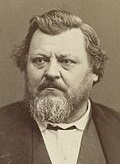
In 1842 German naturalist August Christoph Carl Vogt (1817-95) discovers the mechanism of apoptosis (programmed cell death) while studying the development of the midwife toad.


The Book That Shook the World? Big year for Bible skeptics, secularists, atheistic scientists, anybody against the ancien regime, as Jehovah, the Source of Life Breathed Into Mud is challenged by Godless Evolution, Mud Coming to Life by Itself After It Bubbles Long Enough? The biggest V for the Devil since Eden? The new 95 Theses, but Darwin is smart enough not to publish it on Halloween? On Nov. 24, 1859 (Thur.) English naturalist Charles Robert Darwin (1809-82) pub. On the Origin of Species By Means of Natural Selection, Or, The Preservation of Favoured Races in the Struggle for Life; the 1st ed. sells out in 1 day; the 1872 6th ed. shortens the title to "The Origin of Species"; the decider, which causes evolutionary "survival of the fittest" theory to triumph among the intelligentsia; English Anglican minister and Cambridge U. prof. of modern history Charles Kingsley (1819-75), who received an advance copy on Nov. 18 writes that he had "long since, from watching the crossing of domesticated animals and plants, learnt to disbelieve the dogma of the permanence of the species", which Darwin adds to the next ed. of his book in a modified form: "He had gradually learned to see that it is just as noble a conception of the Deity to believe that He created a few original forms capable of self-development into other and needful forms, as to believe that He required a fresh act of creation to supply the voids caused by the action of His laws"; Darwin pub. it after spending eight years dissecting barnacles in his basement, then inexplicably switching to the Galapagos finch?; catches on first in Germany among atheists?; "If it could be demonstrated that any complex organ existed, which could not possibly have been formed by numerous, successive, slight modifications, my theory would absolutely break down"; Louis Agassiz of the U.S. opposes Darwin, preferring a theory of "Epochs of Creation", based on the absence of missing links between layers of well-formed fossil ecosystems; the phrase "I'll be a monkey's uncle" is coined by Darwin skeptics; "There is a grandeur in this view of life that, whilst this planet has gone cycling on according to the fixed law of gravity, from so simple a beginning endless forms most beautiful and most wonderful have been, and are being, evolved"; what was that about "my theory would absolutely break down" if anything is found that can't be explained by "numerous, successive, slight modifications"?; in practice Darwinism becomes a religion which denies that there is intelligent design in Nature, and therefore tries to deconstruct any evidence of it they find as they go along, yet clings to the notion of common descent, almost as if there was some original, er, accident, and ends up turning into a narrow naturalistic dogma by the end of the 20th cent., taking over U.S. and other Western educational systems with a chilling priesthood? In 1860 after failing to fit it into his Theory of Evolution, Darwin writes the immortal soundbyte: "The sight of a feather in a peacock's tail makes me sick." On Feb. 1, 1871 he writes a Letter to Sir Joseph Dalton Hooker, with the soundbyte: "It is often said that all the conditions for the first production of a living organism are now present, which could ever have been present. But if (and oh! what a big if!) we could conceive in some warm little pond, with all sorts of ammonia and phosphoric salts, light, heat, electricity, &c., present, that a protein compound was chemically formed ready to undergo still more complex changes, at the present day such matter would be instantly absorbed, which would not have been the case before living creatures were found." On Feb. 24, 1871 he pub. The Descent of Man, and Selection in Relation to Sex, which applies his theory of evolution to humans; "The Simidae then branched off into two great stems, the New World and the Old World monkeys; and from the latter at a remote period, Man, the wonder and glory of the universe, proceeded"; "We civilized men... do our utmost to check the process of elimination; we build asylums for the imbecile, the maimed, and the sick; we institute poor laws; and our medical men exert their utmost skill to save the life of everyone to the last moment... Thus the weak members of civilized societies propagate their kind. No one who has attended to the breeding of domestic animals will doubt that this must be highly injurious to the race of man. It is surprising how soon a want of care, or care wrongly directed, leads to the degeneration of a domestic race; but excepting in the case of man himself, hardly anyone is so ignorant as to allow his worst animals to breed"; attempts to scientifically establish white racial supremacy, with the soundbytes: "Western nations of Europe immeasurably surpass their former savage progenitors and stand at the summit of civilization"; "American aborigines, Negroes, and Europeans differ as much from each other in mind as any three races that can be named"; "Looking to future generations, there is no cause to fear that the social instincts will grow weaker, and we may expect that virtuous habits will grow stronger, becoming perhaps fixed by inheritance... [so that] virtue will be triumphant"; "It is the most closely allied forms... which, from having nearly the same structure, constitution, and habits, generally come into the severest competition with each other; consequently, each new variety of species, during the progress of its formation, will generally press hardest on its nearest kindred, and tend to exterminate them"; "This is the book that contains the foundation in natural history for our view" (Marx to Engels); this book is later used by Eugenicists to justify euthanasia of misfits, using soundbytes incl. "We civilized men... do our utmost to check the process of elimination; we build asylums for the imbecile, the maimed, and the sick; we institute poor laws; and our medical men exert their utmost skill to save the life of everyone to the last moment... Thus the weak members of civilized societies propagate their kind. No one who has attended to the breeding of domestic animals will doubt that this must be highly injurious to the race of man. It is surprising how soon a want of care, or care wrongly directed, leads to the degeneration of a domestic race; but excepting in the case of man himself, hardly anyone is so ignorant as to allow his worst animals to breed.... All do good service who aid toward this end."



On June 30, 1860 English biologist Thomas Henry Huxley (1825-95) (who coined the term "agnostic") debates with liberal Anglican divine (bishop of Oxford since 1845) Lord Samuel Wilberforce (1805-73) (a fellow of the Royal Society and son of abolitionist William Wilberforce who is known as Soapy Sam from his holy hand-washing gestures) on Darwinian evolution at Oxford U., helping to push it over on the public, although Wilberforce held his ground and got off a good one by asking Huxley whether it was through his grandfather or grandmother that he claims descent from a monkey, to which he replies that he would not be ashamed to have a monkey for his ancestor, but would be ashamed to be connected with a man who used his great gifts to obscure the truth; blind economist Henry Fawcett (1833-84) shouts out that Wilberforce must have never read a word of Darwin's "Origin of Species", and gets away with it because Bewildered Force knows he's blind? - he didn't respond that all Bible thumpers are apes, he just hoped to be understood that way?

In 1862 German botanist Julius von Sachs (1832-97) discovers that starch is produced by photosynthesis. In 1865 he discovers that chlorophyll in plants is found only in small bodies (later termed chloroplasts), and that chlorophyll is the key compound in combining carbon dioxide and oxygen to produce starch while releasing more oxygen.

In 1866 Potsdam, Prussia-born German zoologist Ernst Heinrich Philipp August Haeckel (1834-1919) ("Darwin's Bulldog on the Continent") ("the Huxley of Germany"), who had a special chair in zoology created for him at the U. of Jena last year bites bigtime on Darwin's theory of evolution, and coins the word "phylogeny" for the origin and evolution of a race of animals or plants, in distinction from "ontogeny" for a single organism, and reveals the new mantra "ontogeny recapitulates phylogeny", AKA the Gastrea Theory AKA Recapitulation Theory; in 1868 he pub. an article on the phylum of (elevated to a kingdom in 1925) Monera, a pious fraud designed to push Darwinian evolution over on the German scientific community (post block ergo propter block?); in 1868 Haeckel pub. The History of Creation (Natürliche Schöpfungsgeschicht), attempting to retrace the evolution of humans, claiming that original speechless proto-humans (Urmenschen) developed separate languages that helped them transition from animal to man as separate species and races, meaning that Semitic and Indo-European languges incl. Jewish, Greco-Roman, Germanic, and Berber languages are the most developed, with the soundbyte: "Human languages probably had a multiple or polyphyletic origin. Human language as such probably developed only after the species of speechless Urmenschen or Affenmenschen (German: ape-men) had split into several species or kinds. With each of these human species, language developed on its own and independently of the others. At least this is the view of Schleicher, one of the foremost authorities on this subject... If one views the origin of the branches of language as the special and principal act of becoming human, and the species of humankind as distinguished according to their language stem, then one can say that the different species of men arose independently of one another"; no surprise, the Caucasian or white race (his) is the highest and most civilized race, and the Negro the lowest and most savage, with the soundbyte: "The Caucasian, or Mediterranean man (Homo Mediterraneus), has from time immemorial been placed at the head of all the races of men, as the most highly developed and perfect. It is generally called the Caucasian race, but as, among all the varieties of the species, the Caucasian branch is the least important, we prefer the much more suitable appellation proposed by Friedrich Müller, namely, that of Mediterranese. For the most important varieties of this species, which are moreover the most eminent actors in what is called 'Universal History', first rose to a flourishing condition on the shores of the Mediterranean... This species alone (with the exception of the Mongolian) has had an actual history; it alone has attained to that degree of civilisation which seems to raise men above the rest of nature"; he adds that Negroes have stronger and more freely movable toes than other races, which links them to the "four-handed apes"; he goes on to theorize that humans arose in India, rather than Africa like Darwin claimed, and that the missing link came from the lost continent of Lemuria, which connected Africa with Asia; "[Haeckel's] evolutionary racism; his call to the German people for racial purity and unflinching devotion to a 'just' state; his belief that harsh, inexorable laws of evolution ruled human civilization and nature alike, conferring upon favored races the right to dominate others ... all contributed to the rise of Nazism" (Stephen Jay Gould).
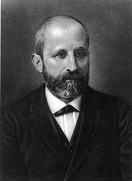
In 1869 Swiss biologist-physician Johannes Friedrich Miescher (1844-95) discovers a weak acid in white blood cell nuclei, which he calls nuclein; in 1871 he isolates it; it turns out to be nucleic acid (DNA); he later discovers that CO2 concentrations in blood regulate breathing.
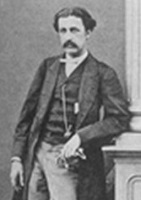
In 1872 English biologist Douglas Alexander Spalding (1841-77) pub. his discovery of Psychological Imprinting in small animals; too bad, it takes decades for his work to be recognized.

In 1872 after finding evidence of life at great ocean depths in 1868-70, Scottish marine biologist Charles Wyville Thomson (1830-82) embarks on an oceanographic expedition in the Challenger (ends 1876), after which he becomes a celeb and is knighted by Queen Vicky.
In 1883 German biochemist Ludwig Karl Martin Leonhard Albrecht Kossel (1853-1927), teacher of Friedrich Miescher at the U. of Strasbourg moves to the U. of Berlin, going on to isolate the five constituent organic compounds in nucleic acid incl. adenine, cystosine, guanine, thymine, and uracil; he later discovers histidine and isolates theopylline from tea, and predicts the polypeptide nature of the protein molecule; "The processes of life are like a drama, and I am studying the actors, not the plot. There are many actors, and it is their characters which make this drama. I seek to understand their habits, their peculiarities."

In 1888 German Bavarian biologist Theodor Heinrich Boveri (1862-1915) discovers the centrosome, which he calls the "special organ of cell division", later discovering the phenomenon of chromatin diminution; in 1902 he proposes that a cancerous tumor starts with a single cell in which the chromosome makeup becomes scrambled, causing it to divide uncontrollably, caused by radiation, chemicals, or pathogens, which is proved true in 1915 by Thomas Hunt Morgan.
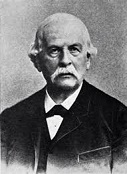
In 1889 German pathologist-histologist Richard Altmann (1852-1900) purifies protein-free DNA, coining the term "nucleic acid' to supplant Friedrich Miescher's term "nuclein", later discovering it contained a large amount of protein; in 1890 he pub. "The Elementary Organism" (Die Elementarorganismen), describing filaments he found in nearly all cell types using a new staining technique, which he calls "bioblasts" but are later found to be mitochondria.

In 1889 Spanish histologist Santiago Ramon y Cajal (1852-1934) discovers the mechanisms of gray matter nerve cells, then in the next two years isolates Cajal's Cells (Cajal-Retzius Cells) near the brain surface, and demonstrates the changes they undergo while functioning, founding modern neuroscience and winning the 1906 Nobel Med. Prize.

In 1897 English biochemist Sir Frederick Gowland Hopkins (1861-1947) proves that a lack of vitamins causes disease, winning him the 1929 Nobel Med. Prize along with Christiaan Eijkman, while the real discoverer, Polish biochemist Casimir Funk is snubbed - that's what I tell my wife?




On Jan. 16, 1902 the existence and function of hormones are discovered by English physiologist Ernest Henry Starling (1866-1927) of University College, London; Starling and English physiologist Sir William Maddock Bayliss (1860-1924) discover the hormone secretin; Am. geneticist Walter Stanborough Sutton (1877-1916) and German biologist Theodor Heinrich Boveri (1862-1915) independently (via work with sea urchins) propose the Boveri-Sutton Chromosome Theory that chromosomes contain genetic info.; Sutton coins the term "gene"; Boveri theorizes that a cancerous tumor starts with a cell that gets its chromosomes scrambled; also in 1902 Bayliss discovers the Bayliss Effect (Myogenic Response), whereby blood vessels contract or distend based on blood pressure to create an autoregulation mechanism.

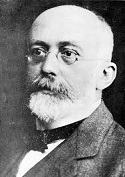
In 1908 English mathematician Godfrey Harold Hardy (1877-1947) and German physician Wilhelm Weinberg (1862-1937) independently propose the Hardy-Weinberg Equilibrium Model (Principle) of the frequency of alleles in a gene pool, stating that they will remain constant through the generations in the absence of genetic drift, mate choice, assortative mating, natural selection, sexual selection, mutation, gene flow, meiotic drive, genetic hitchhiking, pop. bottleneck, founder effect, and inbreeding; known as the Hardy Principle until 1943 when Weinberg's more complete paper is discovered.

In 1909 Belgian scientist (Roman Catholic priest) Frans Alfons Janssens (1865-1924) first describes chromosomal crossover (crossing over), calling it "chiasmatype", making a fan of Columbia U. geneticist Thomas Hunt Morgan, who applies it to his research on the heredity of Drosophila melanogaster.

In 1911 after the 1900 rediscovery of Mendelian inheritance leads him to study the fruit fly Drosophila melanogaster in his Fly Room at Columbia U., Lexington, Ky.-born geneticist Thomas Hunt Morgan (1866-1945) (Doubting Thomas Hunts for More Gain?) announces his theory of Genes (a word he coined in 1904), and how they are linearly arranged on the chromosome and can be mapped, winning him the 1933 Nobel Med. Prize for linkage mapping; he shares the prize money with collaborators Calvin Bridges and Alfred Sturtevant.
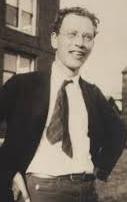
In 1911 Jacksonville, Ill.-born geneticist Alfred Henry Sturtevant (1891-1970), student of Thomas Hunt Morgan invents the procedure of linkage mapping based on the crossing-over frequency; in 1913 he constructs the first genetic map of a chromosome after determining that they are arranged in a linear fashion like beads on a necklace, with each gene in a fixed location (locus).

In 1913 Harvard chemist-biologist Lawrence Joseph Henderson (1878-1942) pub. The Fitness of the Environment: An Inquiry into the Biological Significance of the Properties of Matter, "an inquiry into the biological significance of the properties of matter", becoming the first major book to develop the concept of fine tuning in the Universe; "The properties of matter and the course of cosmic evolution are now seen to be intimately related to the structure of the living being and to its activities; they become therefore, far more important in biology than has been previously suspected. For the whole evolutionary process, both cosmic and organic, is one, and the biologist may now rightly regard the universe in its very essence as biocentric"; "One of the remarkable physical properties of carbon dioxide is its degree of solubility in water. This quality varies enormously in different substances. For example, at ordinary pressures and temperatures, water can absorb only about 5 per cent of its own volume of oxygen, while it can take up about 1300 times its own volume of ammonia. Now for carbon dioxide, unlike most gases, the volume that can be absorbed by water is nearly the same as the volume of the water. The volumes vary, however, according to temperature, being absolutely the same at a temperature of about 15ºC. or 59ºF., which is close to the ideal temperature for man's physical health and practically the same as the mean temperature of the earth's surface when all seasons are averaged together"; "Hence, when water is in contact with air, and equilibrium has been established, the amount of free carbonic acid in a given volume of water is almost exactly equal to the amount in the adjacent air. Unlike oxyzen, hydrogen, and nitrogen, carbonic acid enters water freely; unlike sulphurous oxide and ammonia, it escapes freely from water. Thus the waters can never wash carbonic acid completely out of the air, nor can the air keep it from the waters. It is the one substance which thus, in considerable quantities relative to its total amount, everywhere accompanies water. In earth, air, fire, and water alike, these two substances are always associated"; "Accordingly, if water be the first primary constituent of the environment, carbonic acid is inevitably the second, - because of its solubility possessing an equal mobility with water, because of the reservoir of the atmosphere never to be depleted by chemical action in the oceans, lakes, and streams. In truth, so close is the association between these two substances that it is scarcely correct logically to separate them at all; together they make up the real environment and they never part company."

In 1921 German embryologist Hans Spemann (1869-1941) postulates an organizer principle responsible for the formative interaction between neighboring embryonic regions, causing embryologists to start searching for the inductive chemical molecule. In 1928 he conducts the first nuclear transfer experiment, going on to win the 1935 Nobel Med. Prize.

In 1923 English bacteriologist Frederick Griffith (1877-1941) observes that DNA carries genes that are responsible for pathogenicity; in Jan. 1928 he reports Griffith's Experiment, demonstration that Streptococcus pneumoniae can transform from one strain into another, becoming the first demonstration of bacterial transformation where a bacterium distinctly changes in form and function, attributing it to a "transforming principle/factor", which is later found to be DNA; he also discovers that hereditary material from dead bacteria can be incorporated into live bacteria.

In 1926 the first plant hormone, Auxin is discovered by Dutch biologist Frits Warmolt Went (1903-90).

In 1928 Ukrainian-born Soviet biologist-agronomist Trofim Denisovich Lysenko (1898-1976) pub. a paper on vernalization, chilling winter wheat seeds to turn them into spring wheat seeds, making him a star with Joseph Stalin, who elevates him to a position of power that he abuses to push Lysenkoism, which rejects Mendelian genetics and claims that the hereditary factors are not only in the nucleus but in the cytoplasm ("living protoplasm"), politicizing science and setting back genetics in the Soviet Union by decades (until 1964).
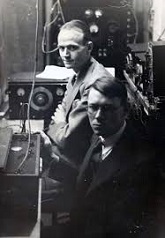
In 1929 Ernest Glen Wever (1902-91) and his asst. Charles William Bray of Princeton U. make a cat telephone to test how sound is perceived by the auditory nerve, discovering the Wever-Bray Phenomenon and the cochlear microphonic, which reproduce a human voice with high fidelity.

In 1930 Dutch-Am. biologist Cornelius Bernardus (Kees) Van Niel (1897-1985) works out the process of photosynthesis in green algae, proving that CO2 and water are converted in the presence of sunlight to chemical energy along with waste O2.

In 1930 Dutch-born physicist Fritz Zernike (1888-1966) of the U. of Groningen in Germany invents the Phase Contrast Microscope, making possible detailed study of living cells by biologists, winning him the 1953 Nobel Physics Prize.

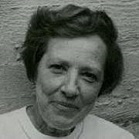
In 1931 Am. geneticists Barbara McClintock (1902-92) and Harriet Baldwin Creighton (1909-2004) demonstrate chromosomal crossover (crossing over) (exchange of genetic material during sexual reproduction) as the cause of genetic recombination; in 1974 after McClintock's 1950 female-only discovery is ignored until some men can take the credit, Am. scientists McClintock, Alan E. Jacob, and Robert W. Hedges officially discover Transposons, genetic elements that can move from one plasmid or its chromosome to another; McClintock wins the 1983 Nobel Med. Prize.
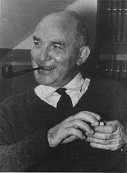
In 1933 Belgian biochemist Jean Louis Auguste Brachet (1909-88) concludes from study of virgin sea urchin eggs that DNA ("thymus nucleic acid") is found in the cell nucleus, and RNA ("yeast nucleic acid") in the cytoplasm.


In 1942 German-born devout atheist evolutionist biologist Ernst Mayr (1904-2005), collaborator of devout Christian evolutionist Theodosius Dobzhansky (1900-75) proposes a new biological species concept that is accepted in scientific circles as the answer to the "species problem", incl. genetic drift, natural selection, and peripatric and allopatric speciation - evolution is just a scientific explanation for a natural process, you can do this?

In 1943 after experimenting on the gigantic single-celled green algae Acetabularia since the 1930s, Danish-German biologist Joachim August Wilhelm Hammerling (Hämmerling) (1901-80) discovers that the nucleus contains the genetic info. and controls development, proving the existence of morphogenetic substances (mRNP).


In 1943 Italian microbiologist Salvador Edward Luria (1912-91) of Indiana U. and German-Am. biophysicist Max Ludwig Henning Delbruck (Delbrück) (1906-81) of Vanderbilt U. (colleagues of Alfred Day Hershey) perform the Luria-Delbruck (Delbrück) Experiment (Fluctuation Test), which shows that genetic mutations arise in the absence of Darwinian selection, rather than in response to it, i.e., by random mutation not adaptive change, bringing bacteria under Darwin's theory, winning them the 1969 Nobel Med. Prize.; Luria also shows that bacterial resistance to phages (viruses) is genetically inherited.



In 1943 the antibiotic Streptomycin, effective in treating TB and bubonic plague is isolated from Streptomyces by Russian-born Jewish-Am. microbiologist Selman Abraham Waksman (1888-1973), who receives the 1952 Nobel Medicine Prize for it, and his Jewish-Am. asst. Albert Israel Schatz (1920-2005), who isn't given credit until he takes Waksman to court and wins; at first effective against bacteria resistant to penicillin, the pesky little buggers develop resistance, and the race for new antibiotics never ends (until ?); Jewish concentation camp survivor Inge Auerbacher (1934-) becomes one of the first to receive the new antibiotic, going on to become a chemist.



In 1944 Canadian-born Am. physician Oswald Theodore Avery Jr. (1877-1955), Canadian-Am. geneticist Colin Munro MacLeod (1909-72), and Am. geneticist Maclyn McCarty (1911-2005) pub. the result of their Avery-MacLeod-McCarty Experiment, which determines that nuclear DNA acts as the carrier of genetic info., and transmutes one type of pneumococcus bacteria into a 2nd type by DNA transfer, founding Molecular Biology - how many years until we're all mixed bags of DNA from Noah's Ark?
In 1944 Erwin Schrodinger pub. What Is Life, in which he suggests that quantum mechanics and coherent ringing in an "aperiodic crystal" might be at the basis of all biochemical reactions.


On July 18, 1950 UNESCO releases The Race Question, written by English-born Jewish-Am. anthropologist Montague Francis Ashley-Montagu (Israel Ehrenberg) (1905-99), black Am. sociologist Edward Franklin Frazier (1894-1962) et al., questioning the validity of race as a biological concept and suggesting the substitution of "ethnic group"; revised eds. pub. in 1951, 1967, and 1978.



The Science of Biology gets its Trinity of Watson-Crick-and-I-forget? Scientific racism gets undermined beyond repair? On Feb. 28, 1953 Chicago-born U.S. biologist James Dewey Watson (1928-) and British Cambridge U. model-making molecular biologist Francis Harry Compton Crick (1916-2004) announce their discovery of "the secret of life", the neat transvestite double-helix structure of DNA, then pub. a 1-page article in the Apr. 25 issue of Nature, drooling "This structure has novel features that are of considerable biological interest", later sharing the 1962 Nobel Med. Prize for it with Kiwi physicist Maurice H.F. Wilkins (1916-2004), who verifies the structure with X-ray diffraction; meanwhile Wilkins' colleague Rosalind Elsie Franklin (1920-58) of Kings College, who also pub. an article in the Apr. 25 issue on her X-ray diffraction studies, and whose work allowed the discovery is left out of the prize - no wonder girls hate math? Too bad, Watson goes on to claim that melanin boosts sex drive, giving dark-skinned people stronger libidos, and that differences in avg. measured IQ between blacks and whites are due to genetics not environment, causing the PC police to target him, getting him suspended from his admin. responsibilities at Cold Spring Harbor Lab where he worked for almost 40 years, forcing him to apologize and retire, which doesn't stop him from repeating his assertion in a 2018 TV documentary, causing him to lose his honorary titles.

In 1956 Chinese-born biochemist Choh Hao Li (1913-87) of the U. of Calif. Medical Center in San Francisco first isolates and purifies Human Growth Hormone (HGH) (Somatotropin), going on to discover its structure in 1966 and synthesize it in 1970 - ask Hao?



In 1957 using an isotope of nitrogen, Am. molecular biologists Matthew Stanley Meselson (1930-) and Franklin William "Frank" Stahl (1929-) perform the Meselson Stahl Experiment, "the most beautiful experiment in biology", which proves that DNA replication is semiconservative, i.e., each daughter cell contains one DNA strand from the original helix.
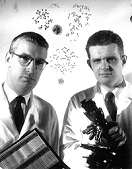
In 1959 Philly-born cancer researcher Peter Carey Nowell (1928-201) and Brockton, Mass.-born researcher David A. Hungerford (1927-93) independently discover the Philadelphia Chromosome (Translocation), an easy-to-detect genetic abnormality of chromosome 22 of lukemia patients, which aids diagnosis.


In 1959 Vienna-born Cambridge U. I-smell-a-Nobel molecular biologist Max Ferdinand Perutz (1914-2001) and his asst. Sir John Cowdery Kendrew (1917-97) develop the first atomic model of a protein, hemoglobin, using blood from a sample of whale meat from Peru , sharing the 1962 Nobel Chem. Prize- Peru, Perutz, can do?




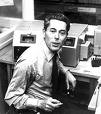
In 1961 South African biologist Sydney Brenner (1927-2019), French biologist Francois Jacob (1920-2013), and Am. biologists Matthew Stanley Meselson (1930-) and Franklin William Stahl (1929-) use phage-infected bacteria to show that ribosomes are the site of protein synthesis and are stable, proving the existence of Messenger RNA (mRNA), and elucidating the triplet nature of the code of protein translation, incl. how frameshift mutations occur when a number of nucleotides not evenly divisible by three are inserted or deleted; Jacob and Jacques Lucien Monod (1910-76) propose that control of enzyme levels in cells occurs through feedback on transcription, becoming the first example of a transciptional regulation system, winning them the 1965 Nobel Med. Prize; Brenner later discovers that the 1mm roundworm Caenorhabditis elegans is an ideal model organism for studying the genetics of animal development, winning him the 2002 Nobel Med. Prize.
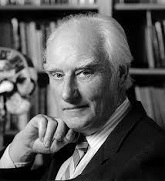

In 1961 British geneticist Francis Harry Compton Crick (1916-2004) and South African biologist Sydney Brenner (1927-2019) discover frame shift mutations (framing error) (reading frame shift), genetic mutations caused by insertions or deletions of a number of nucleotides in a DNA sequence that is not divisible by three.

In 1962 after developing the first inverted microscope for cell culture research in 1959, Am. anatomist Leonard Hayflick (1928-2024) of the U. of Penn. discovers the Hayflick Limit, the maximum number of times a normal somatic differentiated human cell pop. will divide before cell division stops, usually 40x-60x (50x-70x?), overturning claims by Alexis Carrel in the early 20th cent. that normal cells in culture can proliferate forever; this is later traced to the systematic reduction of the length of the telomeric region at the end of chromosomes, which cancer cells get around via expression of the telomerase enzyme; he goes on to create the human cell straing WI-38, the first free from contaminating viruses, the first to discover that walking (atypical) pneumonic isn't caused by a virus, the first to create a mycoplasma (smallest free-living organism, and become a co-founder of the Nat. Inst. on Aging and pres. of the Gerontologist Society of Am.

In 1961 after Am. microbiologist Maurice Ralph Hillerman (1919-2005) of Merck & Co. discovers that simian viruses can contaminate vaccines, Jonas Salk's polio vaccine is recalled and replaced with Albert Sabin's oral vaccine.

In 1961 Canadian scientists James Edgar Till (1931-) and Ernest Armstrong McCulloch (1926-2011) prove the existence of Stem Cells by using radiation to destroy the blood cells of lab mice, then injecting bone marrow from genetically identical mice and observing that all types of blood cells are formed - talk about getting your strong arm and hand in the eager till and McCulling in earnest?

In 1963 Am. biologist Alexander Rich (1924-) discovers Polysomes, clusters of ribosomes that read a single strand of mRNA simultaneously.

In June 1967 Austrian-born Australian biologist Sir Gustav Victor Joseph Nossal (1931-) proposes that antibodies work by detecting the size and shape of their target molecule in order to attach themselves to an antigen.

In 1969 U.S. Public Health Service virologist Robert Joseph Huebner (1914-98) pub. his Oncogene Theory, suggesting that viruses or single genes may trigger dangerous cell overgrowth, interacting with normal genes to produce cancer.



In June 1970 Am. biologists David L. Baltimore (1938-), Howard Martin Temin (1934-94), and Renato Dulbecco (1914-2012) of MIT report the discovery of Reverse Transcriptase, an enzyme in RNA that can synthesize DNA, winning Temin and Baltimore the 1975 Nobel Med. Prize; previously it was believed that only DNA can be used to manufacture more DNA; Retroviruses, which make DNA using an RNA template become a new field of research.
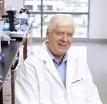


In 1970 Am. microbiologist Hamilton Othanel Smith (1931-) discovers Restriction Enzymes, which can break DNA molecules in predictable places, leading Am. microbiologist Daniel Nathans (1928-99) next year to break up a cancer virus, which eventually leads to its complete genetic mapping; Smith, Nathan, and Swiss microbiologist Werner Arber (1929-) later receive the 1978 Nobel Med. Prize for their work on restrictive enzymes.

In 1971 Japanese-born Canadian cell biologist Yoshio Masui (1931-) of the U. of Toronto and Am. developmental biologist L. Dennis Smith of Purdue U. independently discover Maturation (Mitosis) Promoting Factor (MPF), which controls when mitosis or meiosis begins in cells.
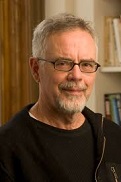
In 1971 Am. evolutionary biologist Robert Ludlow "Bob" Trivers (1943-) proposes the theory of Reciprocal Altruism, followed in 1972 by Parental Investment, followed in 1973 by facultative sex ratio determination (that mammals can determine the sex ratio of their offspring to maximize their own reproductive success) (proved in 2013), followed in 1974 by Parent-Offspring Conflict, followed in 1976 by self-deception as an adaptive evolutionary strategy, founding the field of Evolutionary Sociobiology; "The chimpanzee and the human share about 99.5 percent of their evoltuionary history, yet most human thinkers regard the chimp as a malformed, irrelevant oddity, while seeing themselves as stepping stones to the Almighty."

In 1973 Russian-born Am. evolutionary biologist Theodosius Grygorovych Dobzhansky (1900-75) pub. Nothing in Biology Makes Sense Except in the Light of Evolution, which disses Bible creationism while supporting theistic evolution so he can stay a devout member of the Russian Orthodox Church, becoming the mantra of the keep-Creation-out-of-public-schools lobby; the reality that the facts of biology are interrelated proves evolution and not a Creator who used a common design kit?; "I am a creationist and an evolutionist. Evolution is God's, or Nature's method of creation. Creation is not an event that happened in 4004 B.C.; it is a process that began some 10 billion years ago and is still under way" - I know I was there?

In 1973 English embyrologist Sir Ian Wilmut (1944-) produces the first live birth of a calf (named Frosty 2) from a frozen embryo; Frosty 1 was from frozen sperm; by 1996 he's into lambs.



In 1977 Philip Allen Sharp (1944-) of MIT and British-born Richard John Roberts (1943-) of Cold Spring Harbor Lab on Long Island independently discover Split Genes, genomic sequences (exons) interrupted by intervening sequences of meaningless info. (introns), found in organisms other than monerans (bacteria and algae). In 1979 Biogen Inc. is founded in Boston, Mass. by molecular biologists Philip Allen Sharp (1944-) and Walter Gilbert (1932-), who develop a way to sequence DNA, after which Gilbert shares the 1980 Nobel Medicine Prize and Sharp the 1993 Nobel Med. Prize.


In 1979 Hertfordshire-born English chemist James Ephraim Lovelock (1919-) pub. Gaia: A New Look at Life on Earth, which proposes the Gaia Hypothesis, that the Earth functions as a superorganism, pissing-off Darwinian evolutionists, who smell a Creator or Intelligent Designer? In 1988 the First Chapman Conference on the Gaia Hypothesis in San Diego, Calif. puts forward the Gaia Hypothesis (Princeiple) (Theory) of English physical chemist James Ephraim Lovelock (1919-) and Am. biologist Lynn Margulis (nee Lynn Petra Alexander) (1938-2011)



In 1981 German geneticist Christiane Nusslein-Volhard (Nüsslein-Volhard) (1942-) and Am. biologist Eric F. Weischaus (1947-) identify genes in the fruit fly Drosophila that serve as markers for body shape and organ arrangement, winning them the 1995 Nobel Med. Prize along with Am. geneticist Edward B. Lewis (1918-2004).
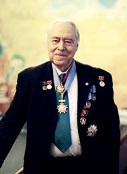
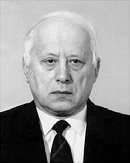

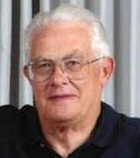
In 1987 Russian meteorologist Yuri Antonovich Izrael (1930-2014), dir. of the Russian Academy of Sciences' Inst. of Global Climate and Ecology and Russian meteorologist Mikhail Ivanovich Budyko (1920-2001), dir. of the State Hydrological Inst.'s Div. for Climate Change Research pub. the study Anthropogenic Climate Change, concluding that parts of the Northern Hemisphere would benefit from some climate change; on Oct. 30, 1998 Budyko gives the speech Global Climate Warming and Its Consequence, with the soundbyte: "On balance, it is very difficult to conclude with higher accuracy whether the projected global warming would be globally beneficial to human society or not." In 2000 Dutch atmospheric chemist Paul Jozef Crutzen (1933-) and Am. biologist Eugene F. Stoermer (1334-2012) (who coined the term in the early 1980s) pub. a paper proposing the term "anthropocene" for the current geological epoch, with the soundbyte: "To assign a more specific date to the onset of the 'anthropocene' seems somewhat arbitrary, but we propose the latter part of the 18th century, although we are aware that alternative proposals can be made (some may even want to include the entire holocene). However, we choose this date because, during the past two centuries, the global effects of human activities have become clearly noticeable. This is the period when data retrieved from glacial ice cores show the beginning of a growth in the atmospheric concentrations of several 'greenhouse gases', in particular CO2 and CH4. Such a starting date also coincides with James Watt's invention of the steam engine in 1784."

On Feb. 22, 1997 English embryologist Sir Ian Wilmut (1944-) et al. of the U. of Edinburgh in Scotland announce the cloning of an adult mammal, a Finn Dorset lamb named Dolly the Sheep (1996-2003) last July 5 (named after singer Dolly Parton for her bodacious tatas), becoming the first mammal to be cloned, named after Dolly Parton because it was cloned from a cell from an adult ewe's mammary gland; it later is put down after a short life marred by premature aging and disease, and when Wilmut reveals that the success rate is 1 in 40 tries, skeptics point out that the whole thing could be a false result; meanwhile on Aug. 7 a Wisc. cattle breeder announces the cloning of a calf in Feb. from stem cells removed from a cow fetus; meanwhile Wilmut also clones a sheep named Polly from a fetal cell that has the human blood clotting factor IX inserted; meanwhile researchers at the Univ. of Bath in England create headless tadpoles, adding to the controversy and stirring fears of coming organ factories - I reckon you ain't from these parts?
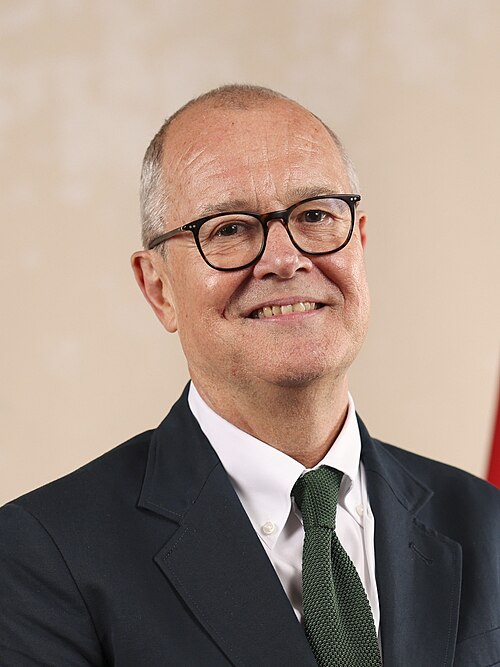
In 1999 English researcher Patrick John Thompson Vallance (1960-) pub. his discovery of the role of nitric oxide in blood vessel dilation; in 2018-23 he becomes the U.K. govt. chief scientific adviser.

In 2006 Japanese scientist Shinya Yamanaka (1962-) and Kazutoshi Takahashi of Kyoto U. in Japan create the first Induced Pluripotent (iPS) Stem Cells, that can develop into any cell type; too bad, less then 1% of adult cells can be reprogrammed into iPS cells until a new technique is found in Aug. 2009 that involves silencing the p53 pathway that prevents mutations and preserves the genome sequence; Yamanaka is awarded a share of the 2012 Nobel Med. Prize.
In 2007 a 405-y.-o. quahog clam is dredged off the N coast of Iceland, becoming the world's oldest known living animal.
On Apr. 8, 2010 Robert Danovaro et al. of Marche Polytechnic U. in Ancona, Italy announce the Spinoloricus Cinzia and two other new species of the Loriciferans group, the first animals that can survive and reproduce entirely without oxygen, who live on the floor of the Mediterranean Sea.
On Oct. 21, 2010 Science pub. an article by scientists from Imperial College London et al., revealing that two strains of the Anopheles gambiae mosquito appear to be becoming different species.
On Dec. 2, 2010 Ed Weiler of NASA announces the discovery of the first known microorganism on Earth that can thrive and reproduce using the toxic chemical arsenic, located in Mono Lake in Calif.
On Aug. 15, 2013 Smithsonian scientists pub. an article in ZooKeys describing the olinguito (Bassaricyon neblina), native to Ecuador and Colombia, a relative of the olingo, becoming the first new carnivore species to be discovered in the W Hemisphere in 35 years.
On June 17, 2014 a UNSW Australia-led team pub. an article in Proceedings of the Nat. Academy of Science reporting a discovery of how algae can switch the quantum phenomenon that occurs in photosynthesis on and off to survive in very low light levels.
On May 14, 2015 scientists at the Nat. Oceanic and Atmospheric Admin. (NOAA) pub. an article in Science announcing the first warm-blooded fish, the opah.
On May 19, 0215 John Dueber et al. of UCB pub. an article in Nature Chemical Biology announcing the creation of a genetically modified yeast that can convert sugar to morphine, and might be used in home beer brewing kits.
On Sept. 16, 2015 the World Wildlife Fund reports that the world fish pop. has halved since 1970, mainly due to overfishing.
In 2015 the world synthetic biology market reaches $4.5B.
On Feb. 9, 2016 researchers at 21st Century Medicine (21CM) announce the first successful freezing and thawing of a mammalian (rabbit) brain.
On Nov. 6, 2017 Ramanarayanan Krishnamurthy et al. of Scripps Research Inst. pub. an article in Nature Chemistry claiming the discovery of synthetic enzyme diamidophosphate (DAP), which drives phosphorylation, claiming it might be the missing link to the first life on Earth.
On Mar. 21, 2018 an article is pub. in Nature Communications reporting that biologists at UCB have used CRISPR-Cas9 to give yeast cells the ability to make flavor components of hops, promising a large water savings in beer-making.
On Apr. 23, 2018 an article is pub. in Nature Chemistry describing the intercalatif motif (i-motif), with the structure of a twisted knot, becoming the first discovery of a non-double helix DNA component within living cells.
On Jan. 3, 2019 researchers at the U. of Ill. and USDA pub. an article in Science reporting on a breakthrough that bypasses the wasteful photorespiration process to increase crop growth by 40%, predicting that it will be used in agriculture in 10+ years.
On Jan. 28, 2019 MIT scientists pub. an article in BMC Evolutionary Biology announcing a reliable new way to determine when certain groups of bacteria appear in the evolutionary record.
On Jan. 19, 2021 Noboru Ikeya and Jonathan R. Wood of the U. of Tokyo pub. an article in Proceedings of the Nat. Academy of Sciences announcing the first observation of live cells responding to magnetic fields via the radical pair mechanism.